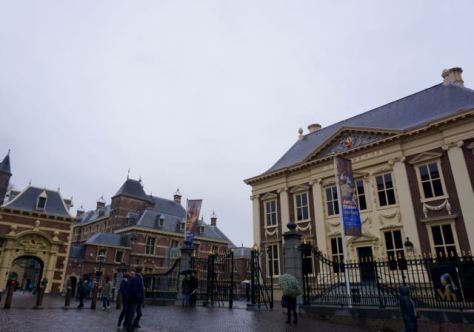The impetus for my trip to Europe was to visit my brother during his semester studying in London, but prior to meeting him, I spent time in Leiden and The Hague, Brussels, and Ghent and Bruges. We chose to meet in Amsterdam because KLM has a direct flight from Amsterdam to Singapore so it would be easy on both of us.
It was raining, windy, and unpleasantly cold when we found each other in Amsterdam’s central train station. I was reading a book next to a baby grand piano that invited travelers to sit and play, heard my brother call my name, and looked up. I hadn’t seen him since July and it was so great to reunite, give him a hug, and go off on an adventure in a place new to both of us. As travelers, we both enjoy just walking around and seeing what there is to see. So, after dropping our backpacks at a storage facility in the middle of the city, that’s mostly what we did for the couple days we were there.
Growing up in the Finger Lakes of upstate New York in a city built around a canal and a river, we’re both used to life along the water but Amsterdam was constructed differently from any city we’d been to. It felt like it was designed for people instead of people fitting themselves around the design. Being in Amsterdam made it easy to understand the emphasis on commerce and exploration that made the Netherlands a European imperialist power. Of course, we loved all the bikes and houseboats, too.
As we wandered, we spent a few minutes in the Begijnhof, the former residence of a Catholic sisterhood who took no vows lived like nuns . . .
. . . stepped into De Krijtberg to verify that it was indeed a church (the Jewish stars above the doors left us a little uncertain) . . .
. . . and walked through a lovely flower market. It’s April in Amsterdam, after all!
Before returning to pick up our bags to take them to our Airbnb, we snacked on Dutch waffles (very different from Belgian waffles) at Albert Cuypmarkt. It sells everything, as markets do, and is located in a cool neighborhood. Market visits are my favorite travel activity because of the diversity of people and products. Look through a market and you’ll know what people buy, what they eat, the cost of living, and how people get along with one another.
We were lucky to find Café Gollem Amstelstraat our first afternoon in Amsterdam and made friends with the bartender while enjoying the largest cheese plate we’d ever seen. I loved that the bar had wifi and people were there working on laptops. Reading the chalkboards on the walls, my brother noticed that they sold Westvleteren 12, often voted the best beer in the world (though this may be changing). Oddly enough, we’d talked about that beer earlier in the day and just looked at each other for a moment.
We asked the bartender if the bar indeed had it in stock. They did. We asked if it was actually the best beer in the world. He hesitated. He told us that it’s been called the most perfect beer and that it’s unique, special, and really indescribable. He confirmed that the scarcity and mythology around it only add to the appeal and assured us that we’d enjoy it, but that we should be aware that we were unlikely to immediately experience a “wow” moment.
At 10.2% alcohol, our second drink of the afternoon, and a price tag of €15, we figured we’d split a bottle. Koen, the bartender, poured the beer into two glasses that looked like wine glasses, reserving the last couple swallows to split into two shot glasses. He told us to wait until the beer warmed up a bit and to drink the shot glass pour, where all the yeast settled, slowly, alongside the glass of beer.
The first thing we noticed was the aroma. Koen was right that we wouldn’t be able to describe it, but it was indeed unique and special. As advertised, the taste of the beer was not a “wow, how delicious” moment; it was more like experiencing beer for the first time in its most perfect, pure form as in, “Oh, this is what beer tastes like.” The liquid in the shot glasses tasted and felt completely different; it had more texture and a deeper taste than the rest of the drink. The whole experience was new and interesting and one that my brother and I were glad to share.
Before we left, Koen told us he’d be hanging out at the bar that night if we wanted to stop by again. He taught us the word gezellig, which I had recently come across (though had no idea how to pronounce) in a book on language and emotion. It means feeling pleasant and cozy with friends, which is certainly how we felt leaving the bar and when we returned later that night.
After it got dark, we spent some time in De Wallen, Amsterdam’s infamous red light district. For obvious reasons, photography isn’t allowed there. (Though everything else seems to be, so maybe it’s not that obvious.) The red light district is full of bars, weed cafés, and shops selling all sorts of interesting objects. And women beckoning provocatively behind glass doors. And promoters advertising shows of all kinds. It took me until much later that night to accurately articulate my reaction to what we’d seen. Without knowing it, and as a result of its absence, I realized that I had expected the atmosphere to playful; it was anything but. Human bodies were up for sale and people were shopping and buying. Sex is an industry and one can buy, sell, and commoditize any and every part of it. The whole thing becomes really dark and grim when you realize you’re walking through a flesh market alive and well on city streets.
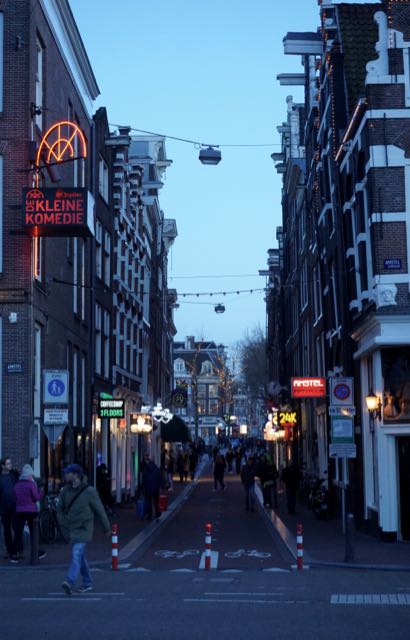
We got up late the following morning and decided to escape the city for a while. We took a train to Haarlem, just 20 minutes west of Amsterdam. After the busy day and late night were glad to be in a much quieter, sunny little town. We stopped for hot chocolate, the special kind where you choose a real piece of chocolate and stir it into steamed milk, and followed my usual plan without a plan of walking towards the tallest building. We found the town’s central square and toured St. Bavo’s Church . . .
. . . and then spent our time wandering through the cobblestone streets and looking into windows of shops and restaurants. We mostly just enjoyed being away from the hustle and bustle of Amsterdam and looking at pretty gardens down little alleys in front of homes and small businesses.
We also enjoyed the architecture outside of the Cathedral of St. Bavo (Bavo was born in Ghent but is the patron saint of Haarlem) . . .
. . . and only stepped inside for a moment to see some very interesting stained glass. Hebrew and other Judaica are very common in Christian buildings if you know where to look, but somehow always surprise me.

Our bartender friend suggested we check out one of his favorite bars in Haarlem, and naturally we did. My tiramisu stout was delicious and my brother had his first sour. Of course, there was cheese to go along with it.

Haarlem also had a bit of an attitude, which made us laugh:
The sun was still out when we walked through Kenaupark along a canal on our way back to the train station late that afternoon. We agreed that Haarlem would be a lovely place to live, both because it’s really nice and because it’s close to a real city.
Back in Amsterdam, desiring to maintain some of the peace and quiet that we had experienced in Haarlem, we followed the canals towards their source in the tributaries off the North Sea. The sky had grown cloudy but I was glad to be on the docks with the boats.
The next morning, we brought our bags to the same storage facility in city center and made our way to the Rembrandt House Museum. I really love seeing how people lived way back in the day. Rembrandt’s life looked quite comfortable and, as my brother pointed out, it’s rare that an artist was so celebrated while still alive.
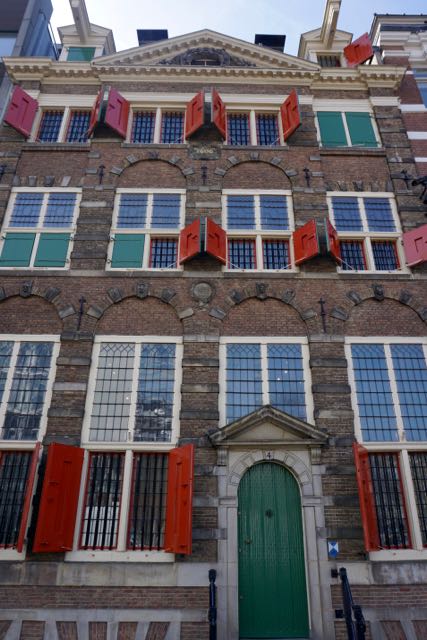
Amsterdam also has a really cool statue dedicated to Rembrandt in the aptly-named Rembrandtplein, the city’s central square:

Feeling cultured, we decided we’d visit one more museum that day. On our way to the museum district, we walked through a flea market selling clothing, shoes, and cool pieces of art . . .
. . . which led us to a statue of Amsterdam native Baruch Spinoza (the birds were symbolic, but I can’t remember why) . . .
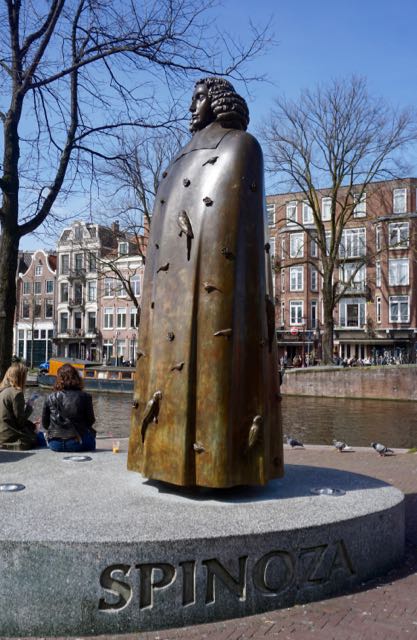
. . . and a memorial to the victims of World War II. . . .
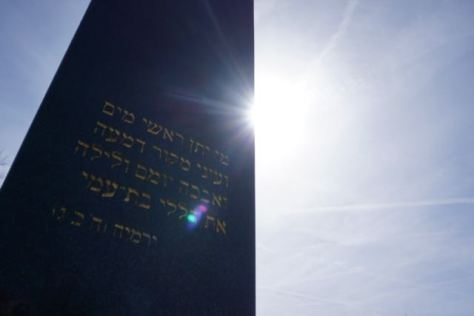
Amsterdam has a historic Jewish Quarter but we didn’t spend much time there. We happened across the Portuguese Synagogue one evening and meant to come back, but that’s the day we went to Haarlem instead. Normally, we would have visited the Anne Frank House, but it was unfortunately closed for Passover until the night that I left. Lucky brother went without me.
Our plan for the last afternoon was to visit the Van Gogh Museum in Vondelpark, full of people on the first warm day all week. On arrival, though, we learned that new rules meant tickets were timed and only available online. Unable to get tickets for that day, we opted for the Rijksmuseum just across the park, which houses very famous Dutch art, including several pieces by Rembrandt we’d learned about that morning.
There were street musicians playing in the covered museum courtyard and we stopped to listen. I’m always impressed with just how talented some people are and it reminds me over and over how difficult it is to make it in the arts worlds.

We had a very late lunch after the museum and wandered around a little while longer, enjoying the canals and the sunshine, before I took a train to the airport. There was a lot I enjoyed about just being in Amsterdam because the people of this city have something to say and want to be heard.
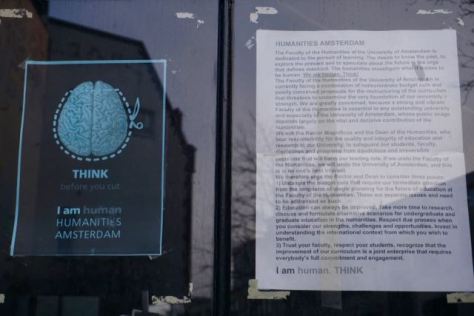
As usual, I appreciated the flavor and feel that street art and graffiti lend to a city. It’s a way of getting to know the people of a place and understand a bit about who they are and what matters to them.
In all, we really enjoyed being in Amsterdam. A city built on canals and for bicycles feels different than many places I’ve been. The graceful bridges and buildings that go right up to the water lend a lot of beauty to the city and I think the locals have a right to be concerned with negative impacts of tourism. Our Airbnb away from city center helped us understand what it means to live in Amsterdam and made me like it a lot more than I did in the crowded tourist areas. As usual, I haven’t seen everything yet, which means I’ll have to come back. Amsterdam, thanks for having us!


















































































































